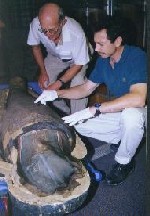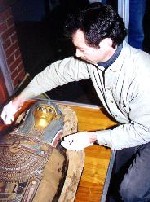Posted on Friday, April 2, 2004
Dr. Jonathan Elias, director of exhibits and programs at the Whitaker Center for Science and the Arts in Harrisburg, will talk about his recent studies on Westminster"â„¢s 2,300-year-old mummy Tuesday, April 13, at 6:30 p.m. in Phillips Lecture Hall located in the Hoyt Science Resources Center.
Elias"â„¢ talk, "Å“"?Egypt"â„¢s Eternal Patients: Recent CT-scan Exploration of Egyptian Mummies,"? focuses on several scientific studies on Westminster"â„¢s mummy, Pesed, including radio-carbon dating, x-rays, and a CT scan. These non-invasive studies were undertaken to solve some of the mysteries of the mummy and to determine if she is related to mummies in a Buffalo, N.Y. museum and at the College of Wooster.
"Å“CT-scans performed on two ancient Egyptian mummies provide a basis for understanding the health and wellness profiles of women in ancient Egypt, and reveal interesting connections between the practice of magic and medicine in Ptolemaic times,"? Elias said.
The Westminster mummy is approximately 2,300 years, old and is believed to be the mummy of Lady Pesed Ma Rheres, single daughter of Heshor, priest of Khem, and his wife Lady Urt. According to radio carbon dating of Psed"â„¢s linen wrappings, her mummification took place some time between 200 and 220 B.C. She was interred in a vast necropolis at the city of Akhmim, Egypt.
Westminster obtained the mummy in 1885, when she was donated to the College by the Rev. John Giffen, a 1872 Westminster graduate who was working as a missionary in Egypt.
Currently, Pesed is on display in the Mack Library in Hoyt Science Resources Center. A virtual tour with animated CT scans and images of the mummy is available on line at http://www.westminster.edu/about/mummy/mummy_overview.cfm.
Elias received his master"â„¢s and Ph.D. from the Department of Anthropology at the University of Chicago. His doctoral studies focused on the use of magical texts on Egyptian coffins after the end of the New Kingdom.
He became interested in the culture of the Akhmim region of Egypt after working on mummies from that area and became increasingly involved in museum exhibit development and in research on ancient regional Egyptian populations. Currently, he is working to organize the Akhmim Studies Consortium, to encourage the use of CT scan technology as a fundamental tool of scholarship on Ptolemaic era mummies.
The talk will also be given at Faculty Forum Wednesday, April 14, at 11:30 a.m. in the McKelvey Campus Center.
The event is sponsored by Beta Beta Beta, Westminster"â„¢s student biology honor society. It is free and open to the public. For more information, contact Dr. Ann Throckmorton, associate professor and chair of biology, at (724) 946-7209 or e-mail athrock@westminster.edu.

